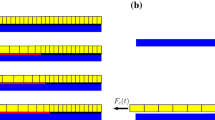Abstract
The growth of a crack located at the interface between two linearly elastic solids is investigated experimentally. It is found that the crack may advance by kinking into either of the adherends or by propagating along the interface itself, depending on the applied loading conditions. The experimentally observed kinking behavior is compared with analytical results. Agreement between these results is improved by suitable manipulation of a presumably material characteristic crack-extension length, the origin of which is rooted in the linearized analysis. The influence of material rate effects on the crack-kinking behavior is also investigated.
Similar content being viewed by others
References
He, M.-Y., andHutchinson, J.W., “Kinking of a Crack Out of an Interface,”ASME J. Appl. Mech.,56,270–278 (1989).
Geubelle, P.H., and Knauss, W.G., “Crack Propagation at and near Bimaterial Interfaces: Linear Analysis,” GALCIT SM Rep. 91-17, to appear in ASME J. Appl. Mech..
Knauss, W.G., and Bowen, J.M., “The Characterization of the Energy of Fracture at or near Interfaces Between Viscoelastic Solids,” GALCIT SM Rep. 91-14, to appear in J. Adhesion.
Knauss, W.G., 1969, “Stable and Unstable Crack Growth in Viscoelastic Media,”Trans. of Soc. of Rheology,13,291–313 (1969).
Knauss, W.G., “On the Steady Propagation of a Crack in a Viscoelastic Sheet: Experiments and Analysis,” GALCIT SM Rep. 73-2, Deformation and Fracture of High Polymers, ed. Kausch, Hassell, and Jaffee, Plenum, Press 501–541 (1974).
Knauss, W.G., “Fracture of Solids Possessing Deformation Rate Sensitive Material Properties,” The Mechanics of Fracture, ed. F. Erdogan, ASME, NY, AMD 19 (Dec. 1976).
Knauss, W.G., andDietmann, H., “Crack Propagation Under Variable Load Histories in Linearly Viscoelastic Solids,”Int. J. Eng. Sci.,8,643–656 (1970).
Mueller, H.K., andKnauss, W.G., “Crack Propagation in a Linearly Viscoelastic Strip,”ASME J. Appl. Mech.,38,Series E,483–488 (1971).
Palaniswamy, K., andKnauss, W.G., “On the Problem of Crack Extension in Brittle Solids Under General Loading,”GALCIT SM Rep. 74-8, Mechanics Today,IV,ed. S. Nemat-Nasser,Pergamon Press,Oxford (1978).
Knauss, W.G., and Mueller, H.K., “The Mechanical Characterization of Solithane 113 in the Swollen and Unswollen State,” GALCIT SM Rep. 67-8 or AFRLTR-68-125 (1967).
Mazor, E., and Bowen, J.M., “Material Selection: An Investigation of the Mechanical Properties and the Aging Behavior of Solithane 113,” GALCIT Ae 100 Rep. (April 1990).
Bowen, J.M., Eng. Thesis, California Instit. of Tech. (1992).
Rice, J.R., “Elastic Fracture Mechanics Concepts for Interfacial Cracks,”ASME J. Appl. Mech.,55,98–103 (1988).
Dundurs, J., “Edge-Bonded Dissimilar Orthogonal Elastic Wedges under Normal and Shear Loading,”ASME J. Appl. Mech.,36,650–652 (1969).
Erdogan, F., andSih, G.C., 1963, “On the Crack Extension in Plates Under Plane Loading and Transverse Shear,”J. Basic Eng. Trans.,85,519–527 (1963).
Author information
Authors and Affiliations
Rights and permissions
About this article
Cite this article
Bowen, J.M., Knauss, W.G. An experimental study of interfacial crack kinking. Experimental Mechanics 33, 37–43 (1993). https://doi.org/10.1007/BF02322548
Received:
Revised:
Issue Date:
DOI: https://doi.org/10.1007/BF02322548




